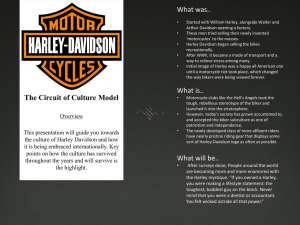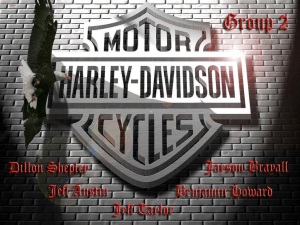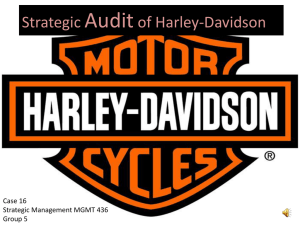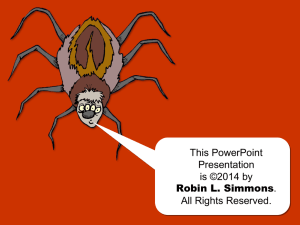Harley Davidson Media Plan
advertisement
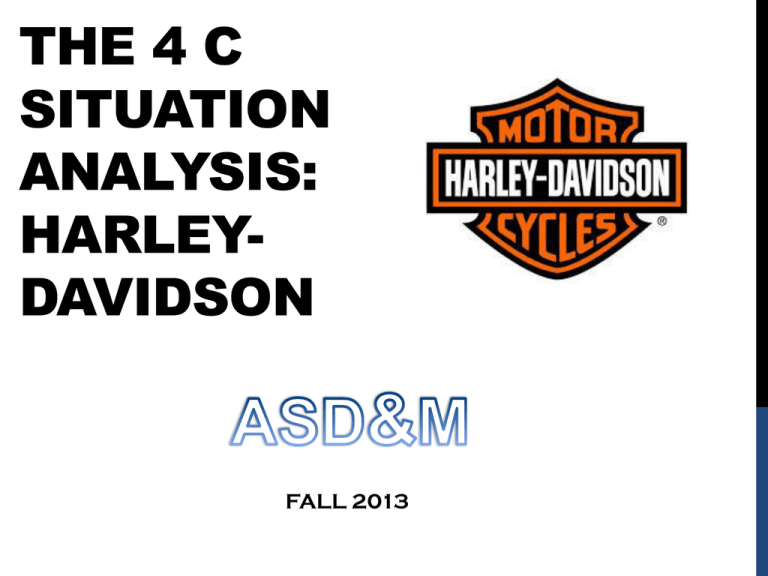
THE 4 C SITUATION ANALYSIS: HARLEYDAVIDSON FALL 2013 EXECUTIVE SUMMARY Harley Davidson is a well-established high end motorcycle brand that has been helping people achieve their dream lifestyle for over a century. Despite its unmistakable brand image and the loyalty of its customers, Harley Davidson is suffering from an ever-aging customer base. The average Harley Davidson customer (upper-class 48- year old male) has been getting older at a rate of 6 months every year for the last 20 years. While Harley Davidson is the largest manufacturer of heavyweight motorcycles in the world by market share, Baby Boomers' children prefer lighter, more inexpensive bikes. This media plan is the result of extensive customer and competition research emphasizing the target audience age issue that Harley Davidson is facing. It will focus particularly on young adults between the ages of 18 and 34, who have finished high school, and own a home. This shift in advertising attention should happen without alienating its already existing older customer base. The goal of this plan will be to increase the target audience's preference and purchase interest by 15% within the following year. CATEGORY: HISTORY After World War II, American soldiers arrived home only to realize that the motorcycles in the U.S. were not as fun nor comfortable as the ones they had used in Europe. That is when the first “bobbers” and “choppers” were created. These bikes were the regular stocked bikes that had been customized by the consumer. The “chopper” finally gained popularity upon the release of the 1969 motorcycle film “Easy Rider.” At this time the main companies that were in the chopper business were Harley Davidson and Indian motorcycles. CATEGORY: TOP BRANDS As of 2012, PowerSports Business published the sales of recreational, on-road motorcycle dealers in 44 states and Canada. CATEGORY: SALES ANALYSIS 1945-2005 Motorcycle Growth Year 1945 1962 1970 1985 2002 2004 2005 Motorcycles Registered in the U.S. (units) 198,000 646,000 2.8 million 5.4 million 936,000 1.1 million 1.2 million The Motorcycle Industry Council lists 1973 as the zenith for annual motorcycle sales, when Americans bought more than 1.5 million bikes. Sales for 1979 topped the one-million mark, then cooled in the 1980s and early 1990s. Motorcycling began its 13 years of increasing success back in 1993, with sales growing every year since. The potential reasons for this steady growth include: Recent Motorcycle Growth A snap-back from the recession. Tough times kept people from buying bikes and low sales kept dealers from replenishing inventory. Motorcycles are far more fuel efficient than cars Sales have appeared to level off over the last 3-4 years. However, recreational motorcycle sales increased just over 2% in 2012 compared to 2011. The Motorcycle Industry Council reported U.S. motorcycle sales for the first half of 2012 have improved: Recreational motorcycle sales rose only 1.8% (to 318,105 from 312,520) between 2011 and 2012 193,287 recreational motorcycles have been sold in the first half of 2012 (January to June), up from 187,571 in the same period the year before (+3.0%) Sales Margin Trends for Private Dealers COMPANY: HISTORY 1901- William S. Harley and Arthur Davidson created their first “motor bicycle” 2004- Harley was involved in several class action lawsuits 1920 Harley-Davidson was the largest motorcycle manufacturer in the world 1969 American Machine and Foundry bought the 1917- The U.S. company and began demanded cutting the workforce motorcycles for combat in WWI, Harley leading to labor strikes and low quality provided 15,000 bikes January 1905Customers could buy a Harley-Davidson engine and create their own bike April 1905- Complete bikes were being sold on a limited bases 1906- Harley built their first factory, allowing them to increase production to 150 by 1907 1907- They began selling their motorcycles for to police departments 1942- Harley continued to create motorcycles for the Army during WWII 2003- Harley bought Buell Motorcycle Company, a sportbike manufacturer 2000- Police departments began reporting high speed instability causing the death of an officer 1980s Harley began to exploit the retro appeal of their bikes, to compete against Japanese bikes 2009- The value of the Harley-Davidson brand fell by 43 2011- Sales improved dramatically, income from operations in the third quarter rose 95.9% COMPANY SALES ANALYSIS Harley- Davidson, Inc. NYSE: HOG 2008 Recession Sales Dramatic increase since 2011 COMPANY: THE 4 P’S • Products • Place: Harley-Davidson motorcycles are purchased through authorized dealerships only. They cannot be purchased through the factory, but they have over 800 stores in the US as well as stores in 67 other countries. • Promotion: • Price: Prices range anywhere from $8,249 to $38,999 COMPETITIVE SPENDING ANALYSIS: AD DOLLARS SPENT BY EACH BRAND Network TV Dols Cable TV Dols Magazine Dols Int Display Outdoor Dols Dols Total Dols HarleyDavidson: Motorcycle 2680 5060.1 1357.5 2370.5 11468.1 Honda: Motorcycle 120.8 3300.4 952.9 918.8 5292.9 Yamaha: Motorcycle 252.4 170.8 163.7 483.5 1070.4 Kawasaki: Motorcycle 568.6 1578.1 340.4 16.4 2 2503.5 Grand Total 3621.8 10109.4 2814.5 3789.2 2 20334.9 MEDIA MIX OF COMPETITIVE BRANDS & TOTAL CATEGORY Network TV Dols Cable TV Dols Magazine Dols Int Display Dols HarleyDavidson: Motorcycle 23.37% 44.12% 11.84% 20.67% 100% Honda: Motorcycle 2.28% 62.36% 18.00% 17.36% 100% Yamaha: Motorycle 23.58% 15.96% 15.29% 45.17 100% Kawasaki: Motorcycle 22.71% 63.04% 13.60% 0.66% .08% 100% Total Category (%) 17.81% 49.71% 13.84% 18.63% 0.01% 100% Outdoor Dols Total Dols SHARE OF VOICE & ADVERTISING EFFECTIVENESS INDEX Market Share Share of Voice Effectiveness Index HarleyDavidson: Motorcycle 35% 71% 49 Honda: Motorcycle 14% 17.6% 80 Yamaha: Motorcycle 15% 8.6% 174 Kawasaki: Motorcycle 15% 2.8% 536 Total Category (%) 79% 100% WRITTEN ANALYSIS Harley Davidson has 71% of the Share of Voice by spending $7,941,600 on advertising through Network TV, Cable TV, Magazine and Internet. While Honda, Yamaha and Kawasaki also tend to focus on these media as well, Harley is the largest investor, spending the most in every category except for Magazine where Honda prevails. Harley Davidson spends the largest portion (33.5%) of its budget on Cable TV ads, which translates to $2,659,700. This is a prominent difference when compared to Yamaha and Kawasaki who only spend 19.3% ($181,900) and 20.2% ($63,600) in the same category. Harley also paves the way in Network TV ads, spending 30.6% ($2,427,800) of its advertising budget compared to Honda who only spends 6.3% ($123,200) and Yamaha with 19.3% (184,000). Kawasaki does spend a large portion of heir ad budget on Network TV with 62.6% going to this medium, but due to their smaller budget, this only translates to $196,900. Harley Davidson is definitely not as reliant on the Internet as some of its competitors. By spending 29.8% ($2,370,500) of its budget in this medium, it seems that Honda (46.7%- $957,000) and Yamaha (50.5%-$483,500) depend on this area to reach their consumers more than any other medium. Harley-Davidson is clearly working hard to advertise their brand in the top media markets and spending comparatively more money to ensure quality in their ads. Overall, however these companies are spending more money in Internet advertising altogether than they are in any other media, by investing 33% ($3,789,200) in the medium. Of the markets they actually utilize, this category is spending the least amount of money in outdoor advertising (.03%- $3,600), which only consists of Kawasaki. None of these companies use Network radio as a means of reaching their audience though. CONSUMER PROFILE/ MRI Proj ‘000 Percent Down Index Education: Graduated High School 3210 33.4 107 Age 45-54 2201 22.9 120 Occupation: Natural Resources, Construction, and Maintenance Occupations 1337 13.9 130 Occupation: Other Employed 2179 22.7 106 HHI: $75,000-$149,000 3295 34.3 116 Census Region: Midwest 2492 25.9 119 County Size: B 2987 31.1 102 Marital Status: Now Married 5416 56.3 102 Child Age: 12-17 Years 2134 22.2 124 Years at Present Address: 5+ years 6183 64.3 112 Home: Owned 7536 78.4 114 Home value: $100,000$199,999 2803 29.2 124 Race: White 8155 84.8 112 Demographic Variable PROBLEMS & • Harley recalled many of its touring bikes built between May 3and October 14, 2013 because of a problem with their hydraulic clutch system • Even with the decreasing average age, the average still remains in the late 40s • Harley “[refuses] to report numbers on its ability to attract customers from new demographics” • Harley only spends 15% of its budget on paid media, and focuses mostly on word of mouth which isn’t effective for the digital age • Still the biggest issue seems to be with the brand image appealing more to the older audience because of its association with 60s rebellion • Harley has had issues with safety and reliability, some are unstable at high speeds • Ali Larkins 2011 Public Relations Plan • • • “Media’s Portrayal of Harley enthusiasts, a stereotype of fringe, flames and old geezers in leather has emerged.” “Our most tangible threat is our (cheaper) foreign competition- Kawasaki, Suzuki, Yamaha and Honda.” “A Harley Davidson motorcycle is considered a luxury item not a necessity.” So people current lack of disposable income threatens the brand OPPORTUNITIES • • • • • • • • They are now making the Iron 883, a cheap bike much like the more expensive Harleys but only $8,399. It has helped them gain 48.6% of the under 35 years of age market. According to RL Polk, a provider of automotive information and marketing solutions to the automotive industry, the average age of the Harley rider is going down, but the average age is 47 (which is one year later than the youngest baby-boomer) The 500cc motorcycle in development could be good for targeting a younger crowd, however it would not appeal to everyone because it will be made in India, not America According to Harley-Davidson’s Chief Operating Officer, Matthew Levatich, they are possibly making an electric motorcycle Their 2014 lineup includes new bikes with many advancements including anti-lock brakes, better headlights, better aerodynamics It sponsors the UFC events Harley is targeting social media for advertising but still only pages that you can “like” Harley is crowd sourcing for a lot of its new advertising MARKETING OBJECTIVE The objective of this 2014 year long branding campaign is to increase sales volume of HarleyDavidson brand motorcycles within the younger user population by 15% TARGET MARKET DEFINITION Demographic Variable Figures and Calculations Age 18-34 29.9% Down High School Grad 33.4% Down Homeowner 78.4% Down Race: White 84.8% Down Target Market Size Calculations .299 x .334 x .784 x .848= .07 .07 x 9,613,000= 672,910 Target Size 672,910 people in target market Name of Target Market Young Adults Target Market Statement Young adults are age 18-34, white, high school grads who own their own home. The size of the target market is 672, 910 people. TARGET MARKET: QUALITATIVE PSYCHOGRAPHIC PROFILE The personification of the ideal target audience for Harley Davidson is hard working, blue-collar, high school graduates. We can name our ideal customer Dave. Dave is usually between the ages 45-54, and has a household income of about $75,000. Dave is married and has children in their teens. Dave is most likely to be from the Midwest region, making him a lover of the outdoors. Dave is a hard worker, who likes to unwind by taking a stroll on his Harley Davidson on the weekends. ADVERTISING OBJECTIVE & POSITIONING STATEMENT Advertising Objective: To increase interest and preference of Harley-Davidson as a viable option of motorcycle transportation through test drives by 15% before the end of 2014. Positioning Statement For men between the ages of 18 and 34, Harley-Davidson is the ideal motorcycle to purchase because it’s big, it’s loud, and it’s all-American MEDIA OBJECTIVES Period Reach Frequency GRP % of Entire GRPS Budget Breakdown January 40 2 80 2.8% $280,000 February 40 2 80 2.8% $280,000 March 70 3 210 7.5% $750,000 April 75 3 225 8% $800,000 May 80 4 320 11.4% $ June 80 4 320 11.4% $ July 40 2 80 2.8% $ August 40 2 80 2.8% $ September 75 3 225 8% $ October 85 4 340 12.1% $ November 85 5 425 15.2% $ December 85 5 425 15.2% $ 2,810 100% $10,000,000 Total MEDIA OBJECTIVES • A pulsing advertising schedule adjusts to the weather dependency of motorcycle usage while emphasizing the high purchase months and maintaining awareness during low purchase months. • To recover from the end of the previous year, in January and February (dead months) start off by reaching a modest 40% of the target audience at least 2 times. • Gradually increase reach and frequency in March and April in preparation for the warmer months and to take advantage of upcoming tax returns, taking GRPs from 2.8% in earlier months to a high point of 8%. • The moderate to warm temperatures in May and June make them the most popular months of the year to motorcycle aficionados. In response to the large percentage of recreational motorcycle sales that take place in these months, bring GRPs up to 11.4% with a combination of 80% reach and frequency of at least 4. • Decrease media budget to $280,000 in July and August, as summer sales are slowing down but to actively keep Harley Davidson in customers' minds. • As the last quarter of the year begins, September and October will serve as stepping stones between the slow late-summer months and the busy holiday months. Reach will increase from 75% in September to 85% in October while frequency stays consistent at 5. • The holidays will improve media receptiveness and gift purchases will lead sales to skyrocket in November and December, making the Harley Davidson end-of-year campaign the most important one of the year. By reaching 85% of the target audience at least 5 times, GRPs will peak at 15.2%. MEDIA STRATEGY: MEDIA MIX Medium Percentage Weight Dollar Amount Interactive 70% $7,000,000 Internet 20% $2,000,000 Cable TV 7% $700,000 Magazine 3% $300,000 MEDIA STRATEGY: SUMMARY • Though there are not currently any figures to support interactive advertising as an advertising medium, we still recommend taking advantage of it so customers can get a first hand experience with the vehicles and make an informed decision to buy a Harley. • Internet Advertising will attract the attention of the new target market who spends much of their time on the internet. As of 2012, the average American spends more than three hours on the internet a day. • We recommend advertising on Cable Television because it is still the most used medium and if the ads are put on the right channels, the target audience should be easily reached. • Magazines have proven to be a successful form of advertising for Motorcycle companies in the past, so Harley should continue to advertise in magazines to reach both its new target market and current target market. MEDIA TACTICS Medium Vehicle Interactive Displays at sporting events Index Number Colum nB (Down) Units Dayparts Weekend Sports Test Drives Motorsports Events Internet Weekend Sports eBay 131 27.7 ESPN.com 86 19.3 YouTube Cable TV Magazine 15 Second ESPN Channel 89 38.4 15 Second TV (Daytime) III (Light) SpikeTV 120 30.5 15 Second TV (Daytime) III (Light) Motorcyclist 356 5.9 Full Page Playboy 119 4.8 ½ Page MEDIA TACTICS: SUMMARY • Displays at sporting events will be a good way of reaching the target audience because many men between the ages of 18-34 are interested in sports so advertising at the games will bring the advertising to the possible customers. • Test Drives will allow possible customers the opportunity to ride the bikes for themselves and come to the conclusion that Harley is the best bike for them. • Motorsports Events are a great place to connect with motor vehicle enthusiasts. • We recommend eBay be used as an advertising medium because its high index of 131. • ESPN.com much like the display ads will target the new demographic where they are already likely to be. • YouTube is currently the third most popular website on the internet and has a very diverse audience. • ESPN will reach the new audience in there homes on one of the most popular channels for men. • Spike TV, with its programming tailored specifically for men and an index of 123, is a great medium for targeting men between the age of 18-34 • Motorcyclist has served motor cycle companies well in the past with its large index, it is one of the most important mediums to continue advertising in. • Much like Spike TV, Playboy is tailored for men and has a relatively large index of 119. FLOWCHART Jan Feb Mar Apr May June July Aug Sep Oct Nov Dec GRP Interactive Displays at sporting events Test Drives Motorsports Events Internet eBay ESPN.com YouTube Cable TV ESPN Channel Spike TV Magazine Motorcyclist Playboy Monthly R/F/GRP 40/2/80 40/2/80 70/3/210 75/3/225 80/4/320 80/4/320 40/2/80 40/2/80 75/3/225 85/4/340 85/5/425 85/5/425 2,810 % of GRP/ Budget 2.80% 2.80% 7.50% 8% 11.40% 11.40% 2.80% 2.80% 8% 12.10% 15.20% 15.20% Budget $280,000 $280,000 750,000 $800,000 $1,140,000 $1,140,000 $280,000 $280,000 $800,000 $1,210,000 $1,520,000 $1,520,000 $10,000,000 WORKS CITED http://www.choppers.com/history.asp http://www.statista.com/topics/1305/motorcycles-in-the-us/ http://www.chopperexchange.com/SellingTips/Tip/1024 http://www.motorcycle-usa.com/6/2014/Buyers-Guide-Manufacturer/2014-Harley-Davidson-Buyers-Guide.aspx http://www.harley-davidson.com/en_US/Motorcycles/motorcycles.html?locale=en_US&bmLocale=en_US http://www.campaignbrief.us/2013/08/harley-davidson-launches-new-t.html http://brand-innovators.com/brandnews/harley-davidson-revs-up-project-rushmore/ Kitano, Taiju, and Hiroshi Ohashi. “Did US Safeguards Resuscitate Harley-Davidson In the 1980s?.” Journal of International Economics 79.2 (2009): 186-197. Business Source Complete. Web. 10 Nov. 2013. Steverman, Ben. “Harley-Davidson: Cruising On Recovery Road?.” Businessweek Online (2009): 8. Business Source Complete. Web. 10 Nov. 2013. PR, Newswire. “Harley-Davidson Earnings, Retail Motorcycle Sales Rise in Third Quarter.” PR Newswire US, 18 Oct. 2011: Regional Business News. Web. 10 Nov. 2013. PR, Newswire. “Harley-Davidson Earnings, Retail Motorcycle Sales Show Continued Strength.” PR Newswire US 24 Jan. 2012: Regional Business News. Web. 10 Nov. 2013. PR, Newswire. “Harley-Davidson First Quarter Earnings, Retail Motorcycle Sales Up Sharply.” PR Newswire US 25 Apr. 2012: Regional Business News. Web. 10 Nov. 2013. “Harley-Davidson Posts 21 Per Cent Jump in 3rd-Quarter Profit On Strong Sales of New Models.” Canadian Press, The (n.d.): Points of View Reference Center. Web. 10 Nov. 2013.
